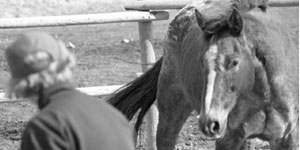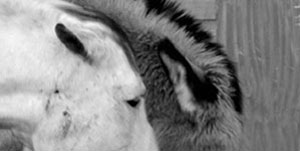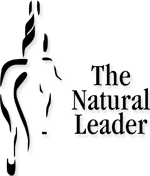Understanding the horse
 Your participation in The Natural Leader programs will help you develop a level of comfort and understanding of horse behaviour you not have previously experienced. With your feet firmly planted on the ground you will be able to experiment, explore and discover how learning with a horse can help you better understand people.
Your participation in The Natural Leader programs will help you develop a level of comfort and understanding of horse behaviour you not have previously experienced. With your feet firmly planted on the ground you will be able to experiment, explore and discover how learning with a horse can help you better understand people.
Looking at leadership concepts through the metaphor of the horse encourages learning in an interactive environment. By observing and reflecting on how our complete opposite acts we are able to use that information to better understand how we and ultimately others around us respond and react.
Throughout a session many of these topics will be repeated – we hope that by providing you with this information in advance it will encourage you to both watch for indications and ask questions.
For those with extensive backgrounds with horses, this information will sound familiar. If however, you are completely new to the world of the equine the following is a brief introduction to the horse.
Predator/Prey Relationship
 The basic difference between horse and human – is the horse is a prey animal and humans are predators, or predatory in nature.
The basic difference between horse and human – is the horse is a prey animal and humans are predators, or predatory in nature.
Everything about how a horse has evolved reflects their ability to survive.
– eyes on the side of the head; giving them great almost 360˚ vision, but they lack good depth perception
– particularly perceptive to danger from: other horses; things; how humans approach them
– they will approach something new indirectly
– have the ability to run within 48hrs of birth
Humans, on the other hand, have eyes in the front of their head and have a great ability to directly focus on something; lack good peripheral vision and often do not recognize danger, people, places or things.
How Horses Think
As a prey species, a horse’s natural instinct is for their own survival. The situation suggests available options, this is also referred to as lateral thinking. On the other hand humans tend to be linear thinkers basing our decisions on reason, a plan or a desired goal.
Each horse is an individual with their own unique characteristics, dislikes and preferences – their own personalities. We often misinterpret these traits as stubborn, dull and a whole list of undesirable qualities. You will likely experience your horse’s preferences.
Horses are gregarious animals and like company, in their way of thinking there is safety in numbers, a single horse is vulnerable.
How Horses Learn
 Horses have an incredible capacity to learn, to learn quickly and learn well. Coupled with a natural willingness to please, this has made the horse extremely useful to us.
Horses have an incredible capacity to learn, to learn quickly and learn well. Coupled with a natural willingness to please, this has made the horse extremely useful to us.
Some horses learn more quickly than others, some are natural leaders others prefer to follow. Watch the dynamics of the herd and see how roles are played out between them.
Every aspect of an individual horse’s behaviour reveals something about what he has learned during his life and how he has learned it.
Learning can be classified into 5 basic categories: habituation, associative, latent, imprinting and insight.
All the horses you will meet have been trained with the same horsemanship principles – a philosophy that allows the horse to find the right solution through associative learning – think of Pavlov’s dogs. The difference is we avoid using harsh tactics, gimics or devises to get the horse to do something. The training tactics or techniques vary among horseman and while the goal is to develop associative behaviours the horse’s response is seldom automatic. A horse’s natural instinct will take precedence and their response will reflect the relationship you have developed.
They look to you to be clear with your communication and fair with your approach and attitude.
How Horses Communicate
 We’ve touched on some of the elements of understanding a horse but the most important consideration in working with them is understanding how they communicate. Their communication is almost 100% non-verbal.
We’ve touched on some of the elements of understanding a horse but the most important consideration in working with them is understanding how they communicate. Their communication is almost 100% non-verbal.
A horse is always consistent with their communication – they use their body language to communicate their intent. A horse is keenly aware of our body language and our intent when we communicate with them.
A horse will never kick without warning, however their warnings can be very quick. A horse can move 10x faster than we likely respond.
Ears pinned back or tail switching vigorously is a warning
Head or butt swinging towards their intended target
They will either bite or kick on the reaction of their target.
A horse will always use these phases of warning.
When a horse is:
– concerned their head is up; ears focused; body tense
– relaxed head is down; ears relaxed; hind leg resting
– listening – ears/eyes focused on you; eyes will be attentive
– asking a question – their head may be elevated; attitude demonstrated by how and where their focus is, likely on you. They may be waiting for clarification, confirmation or additional information.
When a horse understands – their head and neck will relax and it is very possible they will lick and chew.
